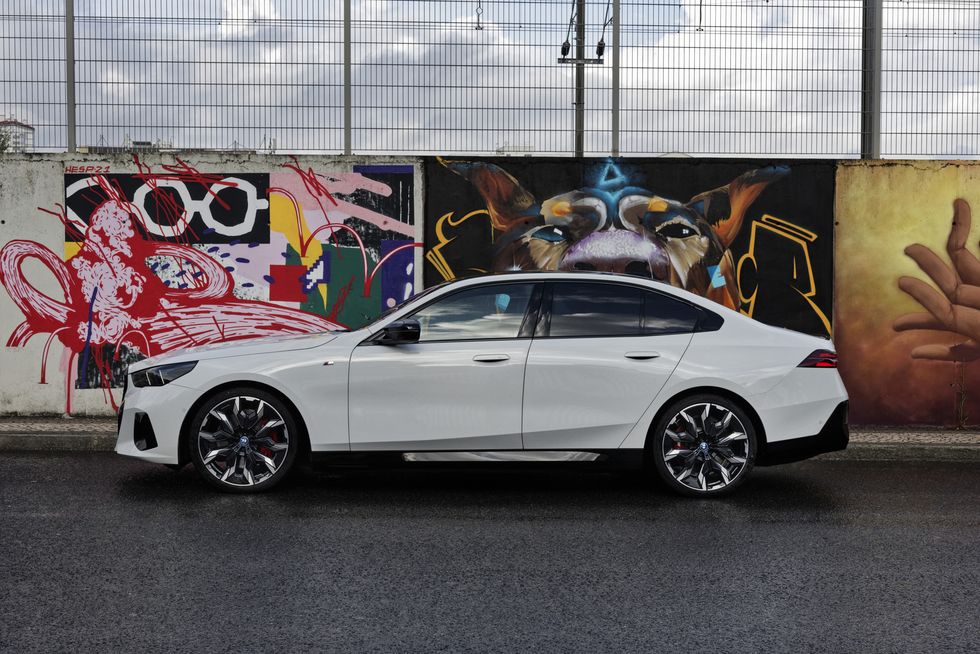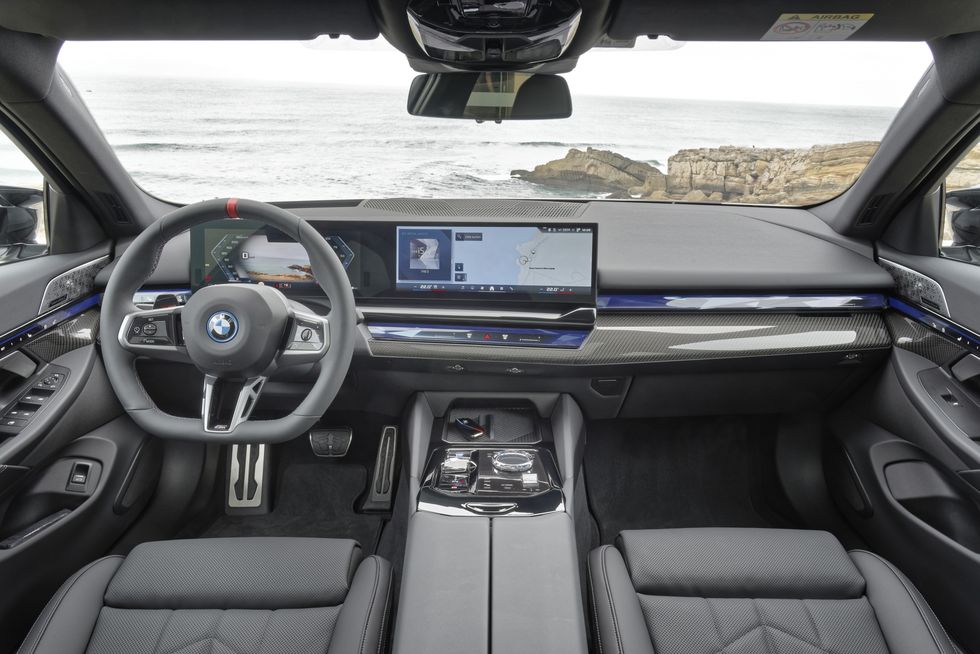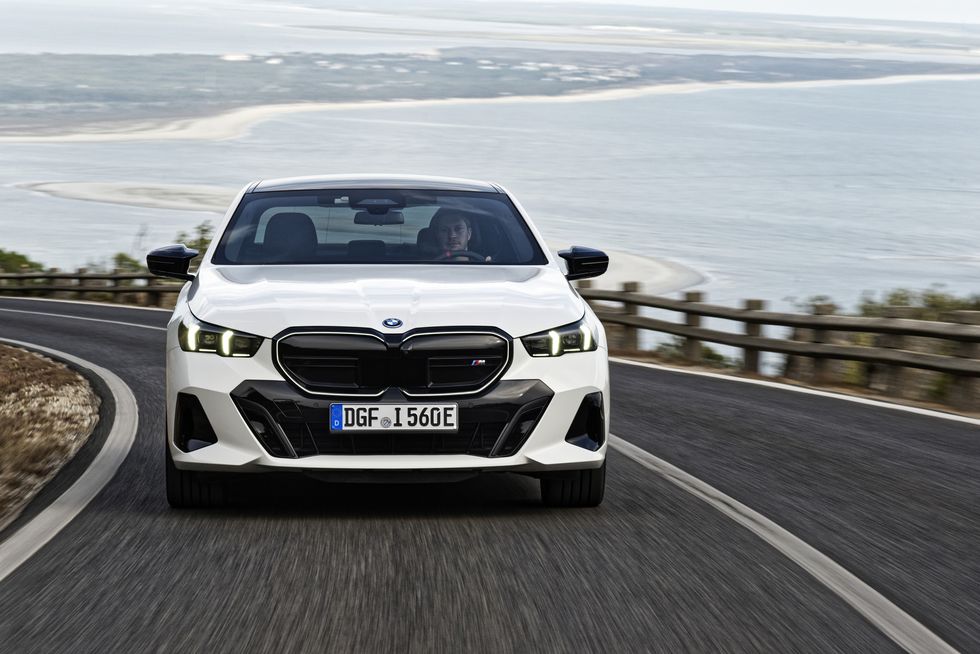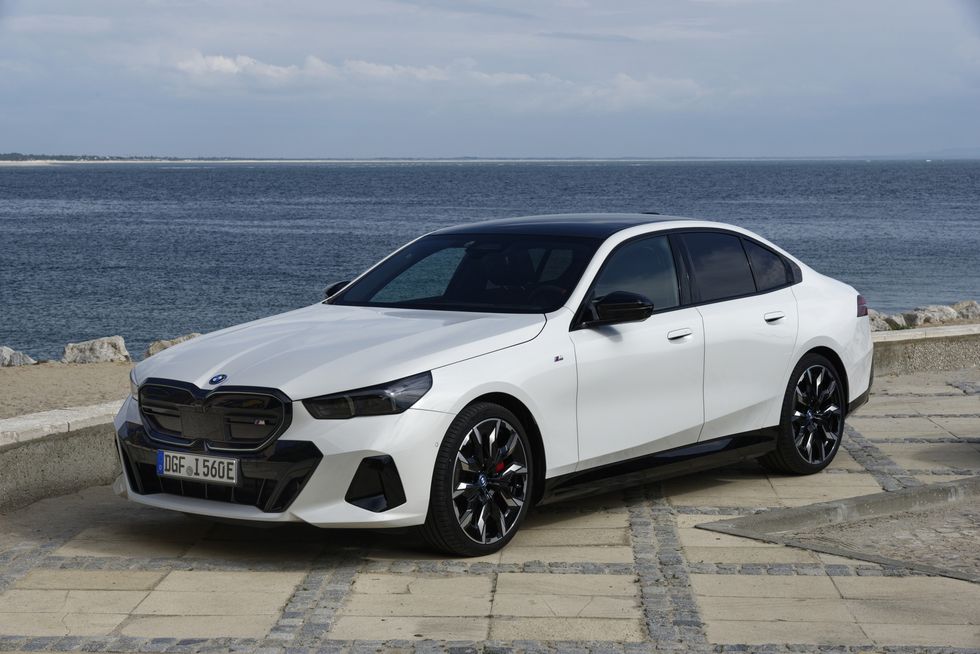In its early phases, BMW and Mercedes-Benz are pursuing two very different approaches to electrification. Mercedes elected to create a separate line of different EV cars, culminating in the EQ carton of battery-electric eggs.

BMW is pursuing the other approach, fitting its EVs into the same bodywork as its gas-powered vehicles. The manufacturer later increased the size to the equally spectacular barge-bodied i7. What it learned from that Luxohammer has now been shrunk down for middle management. The resulting 2024 i5 electric vehicle is equally enthralling.
2024 BMW i5 Interior
The interior is considerably more similar to the i7’s, which is good because BMW nailed it with that vehicle. Under a single pane of glass that spans half the dashboard, a 12.3-inch digital gauge cluster, and a 14.9-inch infotainment touchscreen are housed.
The switchgear is restricted to the area forward of the central armrest. The lovely strip of ambient lighting remains, encircling the front half of the cab in high-end crystalline splendor.

The polymers used to build the door panels and window controls are not as high-quality as those used in the 7, but they still feel extremely pleasant. Nevertheless, with their huge central console, the contemporary Mercedes interiors might feel confining. The inside of the Bimmer is about as claustrophobic as an elevator.
2024 BMW i5 Exterior
If you thought the i7’s split-headlight front end and call-an-orthodontist underbite rear were a little too strange, you’d probably appreciate the i5’s far more classic three-box form. Single-piece headlamps flank right-sized kidney grilles.

A pair of different character lines attract your attention backward and end at a bumper that does not resemble a pint of Cold Stone left out in the sun. Although 3.8 inches larger, 1.3 inches wider, and 1.4 inches higher than the previous 5-series generation, the EV appears to be a touch tighter in person.
The single-motor i5 eDrive40 performed admirably. The major purpose of this device is comfort—mission accomplished. Air springs are standard in the rear, with coil springs in the front.

It was like going from decaf to full espresso when I switched to the i5 M60. While the eDrive40’s acceleration was sufficient, the M60’s was almost superfluous, suiting the M emblems adorning the body.
This model’s suspension features M-specific tuning, so it rides somewhat stiffer than the eDrive40 while remaining compliant enough for regular driving.
2024 BMW i5 Performance
The single motor in the rear-wheel-drive i5 eDrive40 produces 308 horsepower and 295 lb-ft of torque—unless you select Sport mode, which increases horsepower to 335.
You can also increase torque by pressing the Boost paddle or using launch control, which raises it to 317 lb-ft. We estimate the i5 eDrive40 will achieve 60 mph in 5.0 seconds.

The all-wheel-drive M60 replicates similar folly but with bigger numbers: standard output is 510 horsepower and 586 lb-ft, Sport mode boosts power to 593, and the Boost-or-launch-control shuffle adds a twist to 605 lb-ft. For this model, our 60-mph est mate reduces to 3.3 seconds.
The same battery powers both i5 models. A lithium-ion battery with you full capacity of 81.2 kWh is housed beneath the body. Put it into a 240-volt Level 2 outlet, which will draw up to 11.0 kW through its integrated AC charger.
On the DC front, the i5 charges faster than its bigger sibling, reaching 205 kW vs. the i7’s maximum of 195 kW. At full speed, this will charge the battery from 10% to 80% in half an hour.
The EPA range estimates for the i5 eDrive40 are 270 to 295 miles per charge, while the Zippier M60 drops it to 240 to 256 miles, depending on tire choice.

The i5, like the i7 M70, offers a new option that can assist you in getting to the next plug if your mental math didn’t quite add up. Max Range mode limits engine performance, reduces peak speed to 56 mph and turns off temperature control.
BMW claims to have retooled its charging algorithms to allow the battery to accept the greatest rate of charging feasible as rapidly as possible and at charge levels greater than “damn near empty.”
BMW claims to have tested the i5’s 400-volt electrical design against 800-volt competitors and believes it is close to charging parity with those more powerful competitors. We’re excited to put that t the test.
Of course, these maximum charging rates are under ideal conditions; given that the present charging infrastructure in the United States is a patchwork of eldritch horrors, expect your findings to differ. The i5 eDrive40 costs $67,7 5, but the M60 jumps to $85,095.

